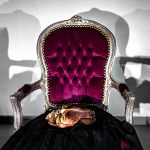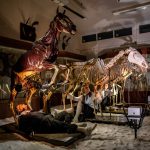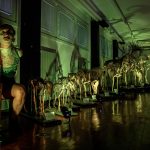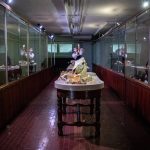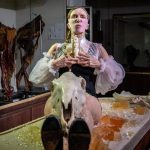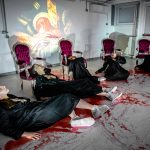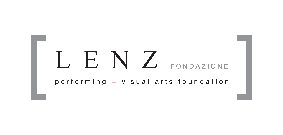
ILIAD #1 CAVALLI
5 – 6 – 9 – 10 – 11 – 12 – 13 June 2025 | ore 21.00
Veterinary Anatomy Museum _ University of Parma, Via del Taglio 8, Parma [maps]
ILIAD #1 CAVALLI
Transfiguration in 12 Prepared
Ma, As a stop stands this column, than on a tomb
It is straight, of a deceased man, of deceased woman,
Sales they were, Property holding the beautiful wagon,
Figging at the Suol Recline the heads; and they flowed to the ground
hot tear, from the eyelashes: For the craving of their lord
cry; and the thick mane was raged,
down from the collar effused, On the one hand and on the other of the yoke.
-
-
Of animal suffering
-
For a dissolution of the hierarchical determination of the living
-
First chapter of anatomical/dramaturgical work on the Homer Iliad and on the structures they define
The suffering of the human animal and non -human animal in an analysis of violence, of the destructive and war act.
Some of the brief moments that illuminate the deserted landscape of the Homeric epic also involve horses, in particular in the seventeenth Book Xanthus and Balius, donated by his father Peleus to Achilles, Immortal animals with the gift of speech and foresight.
At the death of Patroclus, who led them in the clash with Hector, the two horses petrified by pain decide not to fight anymore. By mourning the death of their human companion they escape the horror of war and the imperative of violence.
The sensitive knowledge of the Animal is a form of knowledge to inspire our contemporary feelings, and it is this thought that permeates CAVALLI, a process of transfiguration in twelve anatomical preparations, chosen from those present in the Veterinary Anatomy Collection of the University of Parma, to give substance to an ethical and poetic vision in which the "non-human" animal is considered unique and unrepeatable like the human.
✩ Ticket office
Full price €20
Reduced €12 under 30, Student people and teachers, AUSL employees, groups of at least 5 people
Special reduced 8 € Student people and teachers of the University of Parma
✩ Reservations
Tel. 0521 270141 | Cell./Whatsapp 335 6096220 | info@lenzfondazione.it
ATLAS ON VIOLENCE Three-year drama and visual culture project 2025_2027 However, the Iliad would not be able to rise to poetry, The multi-year dramaturgical investigation is aimed at finding these bright moments After the four-year project on the Holy Scriptures, What happens in the world and what they have delivered us in terms of writings and images-imagination-Immaginal, leads us to an analysis of violence, of the violent act, of the mythical hero and of the war. Atlas on violence is the new multi -year project with anatomical work starting from the Iliad, Truth and beauty, between divine figures and heroes in perennial struggle, they seem to be scanning temporal brackets Truth and beauty of figures that emerge above the battle, of victory or defeat, of honor and glory, of the hero whose powerful humanity emerges above all in the weakness of a crying or in the embrace of blood brothers with the fall of the night, of the role imposed on the prisoners of the defeated city or in the implorely pity of those who ask for the body instituted their child. But then the war resumes even more violent, And the victory is obtained with deception. For Simone Weil the Trojan War is the paradigm of every war; Homer was able to describe evil and the inability of evil to contaminate good, the continuous struggle between strength and bestiality, the hero's loneliness and pity, because only in these parentheses of mortal beings do the soul and thoughts awaken from the dark night of a war that lasted ten years. The poem contains within itself all the elements that will give rise to Tragedy in its most complex and complete forms. Every ethical-aesthetic reference to our present requires critical dramaturgical thought that draws the boundaries between epic thought, heroic figure and form, between strength and power on the field to be able to draw its true meaning: he who has strength also has power? Or the real power belongs to those who do not recognize strength and violence, After having undergone them, as inescapable? A theater that has its own agone in the contemporary can not be separated, poetry – terrible weapon of defense – it cannot be separated. Transfiguration in 12 Prepared Gathered to the ossifications of the descendants of the two immortals, We will return fluids and beats to the dry preparations kept in the boys of the zooiatric museum and pierced by the violence of the hierarchy against nature we can know of their suffering, of their wounds, of their tears and ours. Veterinary anatomical collection a. Lemoine CAMERA Transfiguration space: Bed MATERIA: SALE ACTION: Observation Zootomy cabinet Galleries Transfiguration space: TABLE MATERIA: JELLY ACTION: CONJUNCTION Sectoral room SALONE Transfiguration space: Armchair MATERIA: BLOOD ACTION: CONVERSION The zootomy cabinet was born together with the veterinary school in 1845. The first director of the school entrusts the task of setting up anatomical preparations, for didactic purposes, to the anomista Alessio Lemoigne. In the 1857 The zootomy cabinet matters well 191 Prepare of various mammals; The anatomist enriches the collection of unique pieces and formal forms that emulate it in the art of dissection. Currently the anatomical veterinary collection preserves 685 anatomical preparations, normal and teratological, products in the 19th and 20th centuries. The exhibition is made up of natural and artificial dry preparations, from pieces set up for corrosion after injection with vinyl acetate and papier -mâché models. Achilles's horses As they saw him dead, ILIAD #1 CAVALLI Transfixions from the Iliad and the writings of Simone Weil
it would just be a monotonous landscape deserted by force,
if there weren't bright moments scattered here and there, brief and divine moments in which men have a soul.
Simone Weil
and imagoturgical on this founding work of Western thought.
The first great book of the West that poetically transcribes themes such as conflict, the abuse,
violence, Empty and a series of performative rewrites connected with the epic of the Iliad.
where time seems to exist, or be infinite and immortal like the life of the quarrelsome and vindictive gods.
Parenthesis where poetry rises above the ferocity of a war whose meaning has been lost,
the ultimate goal of the dispute.
Not their for us – exploited, swallowed, brutalized, sacrificed – but we converted to them, fertilized, Hybrid, re -founded, recreated.
Costantino Kavafis
He so good so strong so tender,
Achilles' horses began to mourn Patroclus –
it was the indignation of their immortal selves
who trembled at that tragic failure.
They bowed their heads, they shook their long manes
and with their nails they scratched the earth complaining
together with hearing him down there lifeless, the spirit
lost, helpless, breathless;
from life returned to the Great Nothingness.
Zeus saw the crying, he took pity on the divine
coursers. And said: “I should have been at Peleus' wedding
act with more caution. Better,
oh my horses, that I had never given in to you!
What were you looking for down there among mortals, among the poor
toys of fate? Ora, here you are afflicted
from ephemeral evils, you that I have done
free from old age and death, and already
share in the troubles of humans". – Nonpertanto
the two noble beasts were always crying
the irrevocable misfortune of death.
Transfiguration in 12 Prepared
Dramaturgy, imagoturgy Francesco Pititto
Composition, installation, wrappers Maria Federica Masters
Musica Andrew Azzali
Interpreter Tiziana Chapel, Aldo Rendina, Sandra Soncini, Carlotta Spaggiari
Technical care, luci Alice Scartapacchio
Production Giulia Mangini
Project care Elena Sorbi
Organization Ilaria Stocchi
Communication, Press office Giovanna Pavesi
Diffusion, graphic care Alessandro Conti
Photographic documentation Elisa Morabito
Video documentation Black Lapine
Production Lenz Foundation
With the support and collaboration ofUniversity of Parma
Department of Social Humanities and Cultural Enterprises
Department of Veterinary Medical Sciences
University museum system
MuDes Widespread Museum of Sciences – “Alessio Lemoigne” Veterinary Normal Anatomy Collection
of the Department of Veterinary Medical Sciences
Thanks Equine Team of the Department of Medical-Veterinary Sciences UNIPR for video contributions







